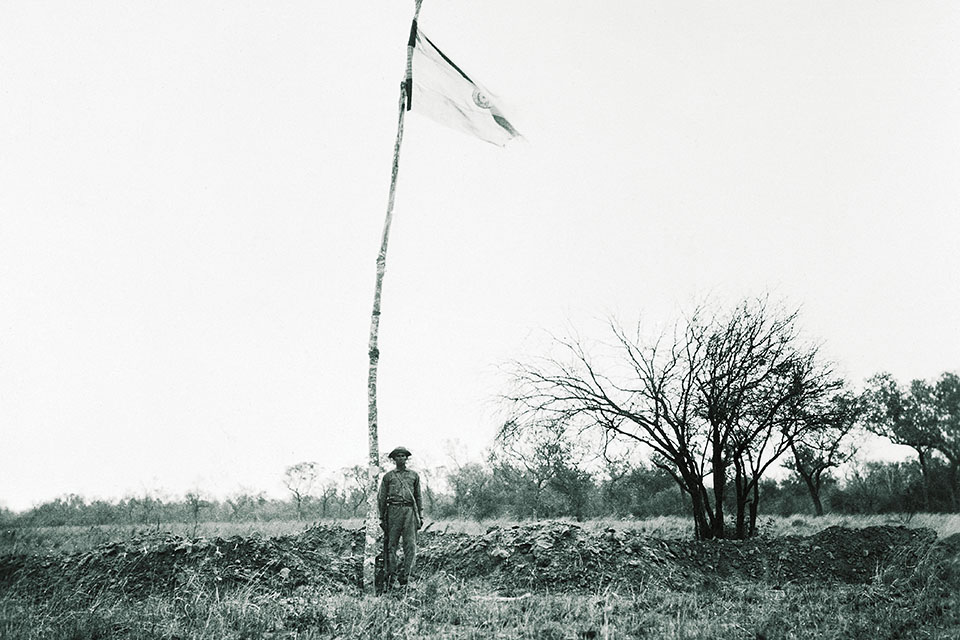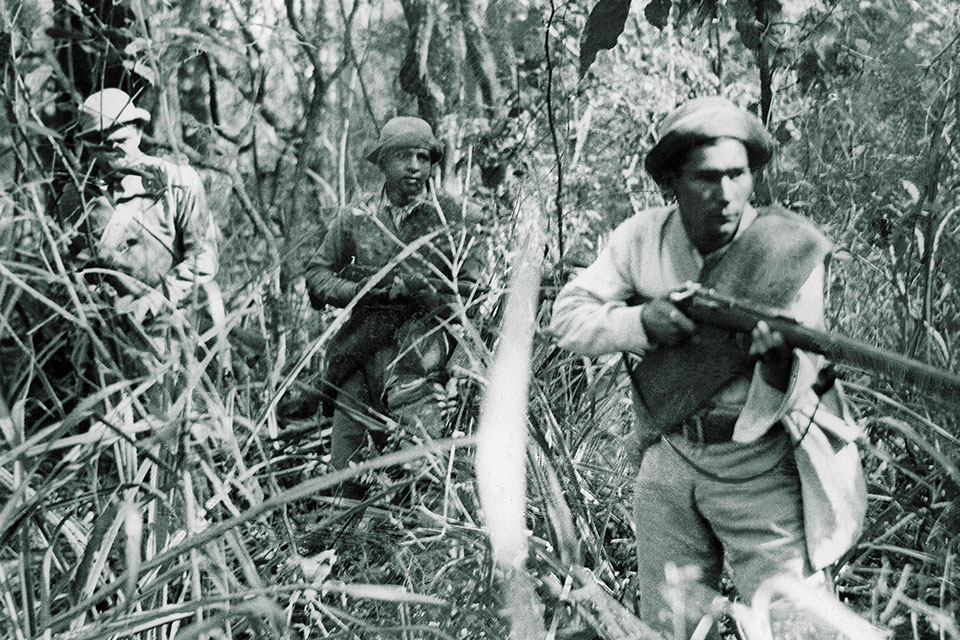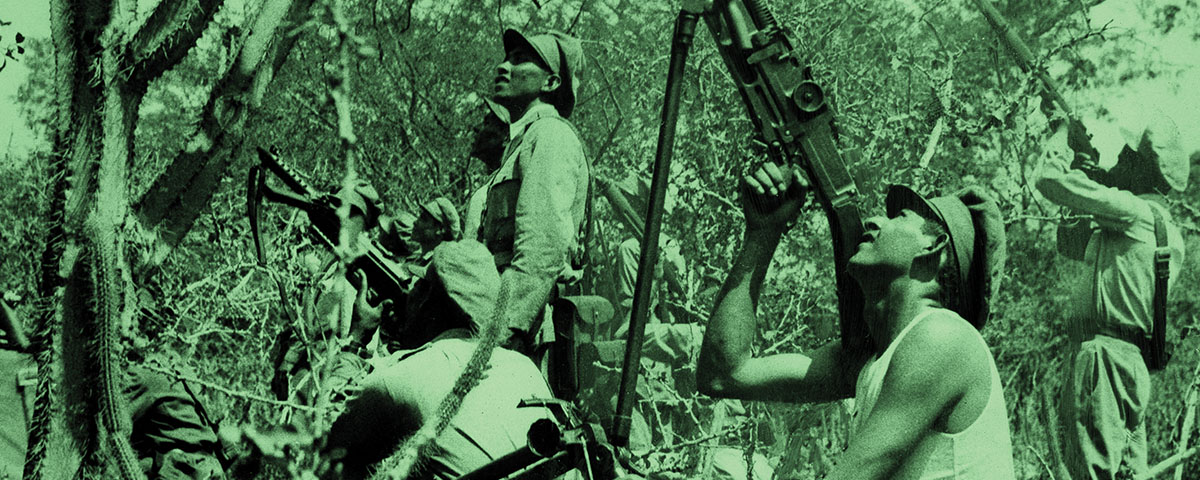In the lull between world wars, Paraguay and Bolivia battled over a wasteland of desert scrub, deadly reptiles and rumored oil deposits
South America’s Chaco Boreal is a deadly place. Temperatures often reach 100 degrees Fahrenheit in the flat, arid region approximately the size of Oregon. The “Green Hell,” as it is known, is home to more than 60 species of snakes, armies of fire ants and jaguars that can strike in a flash. Historically, Paraguay and Bolivia both laid half-hearted claim to this desolate region, which forms a rough triangle bound by the Pilcomayo River to the southwest, the Paraguay River to the east and the foothills of the Andes to the north. But no one, other than small bands of nomadic Amerindians, paid much attention to the Chaco.
All that changed in the years between the world wars.
In the interest of maintaining their respective claims to the region, Paraguay and Bolivia established small outposts, or fortines, throughout the Chaco. These positions often comprised little more than a few mud huts, barbed wire entanglements and a flagpole. The rival nations also periodically sent out small patrols to probe the other’s positions. Inevitably these patrols collided with one another, escalating tensions.
In February 1927 soldiers at a Bolivian outpost captured a five-man Paraguayan patrol and later killed its commander, Lt. Adolfo Rojas Silva, reportedly as he attempted to escape. Bolivia notified Paraguay of Silva’s death and repatriated the prisoners. Though outrage rocked the Paraguayan capital of Asunción, cooler heads prevailed, and diplomats negotiated a peaceful resolution. Still, the incident inflamed the smoldering hostility between the adversarial nations, and each added outposts in the Chaco.
In the belief open warfare in the Chaco was only a matter of time, both Paraguay and Bolivia accelerated efforts to modernize their military forces. The Bolivian army, which numbered about 8,600 men in 1927, had begun its campaign of modernization in the early 1900s, eventually under the tutelage of a German military mission under Major Hans Kundt, a competent, if unimaginative, administrator and drillmaster. After commanding a German brigade in combat against the Russians during World War I, General Kundt returned to Bolivia. (Among his officers was Ernst Röhm, who would later achieve notoriety in Nazi Germany as the commander of the Sturmabteilung, Adolf Hitler’s infamous “Brownshirts.”) In addition to modern infantry rifles and field artillery, Bolivia acquired a variety of heavy and light machine guns and anti-aircraft weapons. It also invested in flamethrowers, Vickers armored vehicles and a number of combat and transport aircraft.
The Paraguayan army, which by 1927 numbered little more than 2,700 men, sent its officers to study at military academies in Argentina, France and Chile. Its quartermasters had purchased Mauser rifles, Maxim machine guns, Krupp field artillery and Stokes-Brandt 81 mm mortars, the latter of which would prove highly effective in the low, dense scrub of the Chaco. Paraguay acquired a limited number of biplane fighters and transport aircraft, while its navy invested in two state-of-the-art Italian gunboats to augment the fleet securing the Paraguay River.
Though anger over the death of Lt. Silva subsided, further clashes again brought the nations to the brink of war. In December 1928 a Paraguayan battalion seized a Bolivian outpost along the Paraguay River at Vanguardia. In response a Bolivian division attacked and occupied several Paraguayan positions, including the stronghold of Boquerón, a few hundred miles northwest of Asunción. Through the auspices of the Pan-American Union (a precursor to the Organization of American States), concerned neighbor states assembled a Commission of Neutrals—comprising representatives from Cuba, Colombia, Mexico, Uruguay and the United States—and met in Washington, D.C., to negotiate a settlement. Within months Paraguay and Bolivia reached accord, withdrew forces and exchanged prisoners, once again averting war.
Years earlier Standard Oil Co. of New Jersey had discovered rich petroleum deposits in the Bolivian foothills of the Andes, and its engineers had since speculated that the oil deposits probably extended beneath the dry, sandy plains of the Chaco to the south, a prospect that further boosted Bolivia’s interest in asserting control over the region. Meanwhile, Standard’s Anglo-Dutch rival Royal Dutch Shell had made lucrative offers to the Paraguayan government for rights to drill for oil under the same tangled scrubland west of the Paraguay River.

The Paraguayan government was also engaged in Chaco land sales, a much-needed source of revenue. Argentinean investors had purchased large tracts of grassland near rivers to support livestock ranches. In a rather incongruous development, Canadian Mennonite farmers had negotiated with Paraguay to purchase land for a self-governing religious colony in the arid heart of the Chaco. It had since drawn thousands of Mennonites from Germany, Switzerland and Russia. Were Paraguay to forfeit control of the Chaco, it would forgo revenue from similar sales.
National pride also played an important role in the rivals’ claims to the region. Paraguay had suffered humiliating defeat in the disastrous 1864–70 War of the Triple Alliance, in which megalomaniacal Paraguayan President Francisco Solano López had taken on the combined forces of Brazil, Argentina and Uruguay. By the time Paraguay finally surrendered, it had lost nearly three-quarters of its population, and the victorious allies were preparing to carve up Paraguayan territory. Only the intervention of U.S. President Rutherford B. Hayes saved Paraguay as a sovereign entity, but its territory was significantly reduced, and it was saddled with heavy war debt. Paraguayan patriotism, which ran strong in its people, would not allow another such loss of territory—not without a fight.
Likewise, Bolivia had endured a humiliating loss to Chile in the 1879–83 War of the Pacific. Bolivia was forced to cede Antofagasta Province—its Pacific Ocean shoreline—thus becoming a landlocked nation in need of a route to the sea by which to export its valuable petroleum. The Chaco provided just such a potential route to the Atlantic Ocean by way of the Paraguay River. Bolivia, whose population was nearly three times that of Paraguay, could not concede to its weaker neighbor’s provocative claim to the Chaco without swallowing its pride.
Adding to the renewed interest in the Chaco, a 1931 Paraguayan military mapping expedition to the region made a startling discovery. Under the leadership of exiled White Russian Maj. Gen. Ivan Belyaev (aka Juan Belaieff), the survey team stumbled on Lake Pitiantutá, a large body of fresh water in the midst of the parched, desolate plains. Such an abundant supply of potable water could open the central Chaco to travel, settlement and the establishment of military fortifications. Belyaev’s hasty construction of Fort Carlos Antonio López, a small outpost along the lakeshore, soon drew Bolivia’s attention.
In what may have stemmed from a miscommunication between the Bolivian army and its government, a Bolivian military expedition seized Fort Carlos Antonio López in June 1932. Intentional or not, the assault prompted a counterattack a month later by Paraguayan forces, who drove the Bolivians from the lake. Bolivian President Daniel Salamanca then yielded to popular pressure for war with Paraguay and authorized a force of 10,000 troops to seize the fortifications around Boquerón. The offensive easily routed the Paraguayan garrisons and captured the town, leaving little to prevent the Bolivians from marching on the Paraguayan city of Concepcíon and the key logistics base of Puerto Casado on the Paraguay River. It appeared Bolivia would secure a quick victory over its smaller foe.
Paraguayan leaders called for full national mobilization. The people responded patriotically, even donating household possessions and wedding rings to the war effort. In a stroke of good fortune for Paraguay, heavy rains turned the Chaco’s few roads into muddy quagmires, temporarily halting the Bolivian advance. But perhaps the best luck for Paraguay was the emergence of Lt. Col. José Félix Estigarribia as operational commander of its army.
In a culture that revered the imposing, powerful caudillo, or strongman, Estigarribia was an unlikely choice for command. He was relatively small in stature and reportedly a man of few words. The son of a peasant silversmith, he had planned to study agriculture before opting for a military career. The 44-year-old colonel had attended France’s vaunted Saint-Cyr military academy and spent time as a frontline observer during World War I. Though he had little practical combat experience, he was a keen strategist.
In early September, taking advantage of the pause in the Bolivian onslaught, Estigarribia rapidly mobilized and concentrated 13,000 Paraguayan troops to retake Boquerón. After three unsuccessful and costly frontal assaults on the Bolivians’ fortified positions, the Paraguayan commander shifted tactics. While fixing the Bolivian defense with frontal pressure, Estigarribia slowly infiltrated around the enemy flanks to envelop the defenders and cut off their supply line. In the torrid heat the besieged Bolivians soon ran out of water, and supplies of food and ammunition dwindled rapidly. In mid-September the Paraguayans cut off a Bolivian relief column before it could reach Boquerón. Bolivian aircraft tried to drop ammunition, rations, medicine and, ingeniously, blocks of ice as a water supply, but the airdrops often fell within Paraguayan lines. On September 29, after a three-week siege, Boquerón capitulated. As the victorious Paraguayans made their way through the pockmarked defenses to reclaim the outpost, they were shocked at the skeletal appearance of the 466 surviving Bolivian defenders, who begged their captors for water.
After retaking Boquerón, newly promoted Col. Estigarribia sustained the momentum by pushing westward toward the Pilcomayo River, driving Bolivian forces out of 15 successive defensive positions and away from Paraguayan population centers. In December seasonal rains brought offensive operations to a halt, as dirt roads in the region became impassable.
Estigarribia’s adaptability as a military leader was one of several factors working in his favor. Most important, he benefited from relatively short lines of communication. Paraguayan troops and supplies traveled by steamer up the Paraguay River, accompanied by the navy gunboats, then transferred to a narrow-gauge railway that ran west roughly 100 miles into the Chaco. The rough last leg to the front was either on foot, pack mule or jolting Ford trucks. The entire journey took about four days, whereas it took weeks of hard travel for Bolivian troops to reach the Chaco front.
Estigarribia’s troops also proved more capable than those of his opponent. The homogenous composition of the Paraguayan army reflected a society that celebrated its mestizo (mixed European and Amerindian) heritage. Almost every Paraguayan proudly claimed descent from both Spanish settlers and indigenous Guaraní people, thus both officers and soldiers shared a common culture. In addition, most Paraguayan troops were hardy campesinos, or peasants, accustomed to tropical heat, primitive conditions and hard work. Although they were poorly equipped, often lacking even shoes, Paraguayan soldiers proved determined, resourceful and resilient.
The Bolivian army, by contrast, was led by an officer corps drawn mainly from the criollo (full-blooded Spanish) class, while the rank and file largely comprised indigenous Andeans. The latter were more acclimated to temperate, hilly conditions than the dusty, oppressive heat of the Chaco. While Paraguayan troops fought to defend their home turf, Bolivian soldiers were thrust into a war for possession of an inhospitable wasteland with little personal meaning for them.
In what proved another significant advantage, Estigarribia had the full confidence and trust of Paraguay’s military high command and civilian leadership, while President Eusebio Ayala allowed the colonel the freedom to command without political interference. To his army’s detriment, Bolivian President Salamanca continuously meddled with and criticized his commanders.
Bolivia faced another sort of leadership crisis. In early 1932 President Salamanca had recalled General Kundt from exile related to a military coup two years earlier. If that weren’t shaky enough ground, many Bolivian commanders took umbrage at the appointment of a gringo as senior commander. The 63-year-old German general was either oblivious or unconcerned. During the rainy season he organized a force of 12,000 troops in the Chaco, and in January 1933 he launched an offensive against the Paraguayan fortifications around Nanawa, very nearly managing to encircle the defenders. The resourceful Paraguayans, however, mounted successful counterattacks against the Bolivians, who repeatedly proved unable to coordinate their forces at the point of attack. The Paraguayans took hundreds of prisoners, further degrading morale in the Bolivian ranks. In March four Bolivian regiments mutinied, the men returning to their home villages in the Andes.
Promoted to general that fall, Estigarribia launched a pincer movement against Bolivian positions around Nanawa. In a decisive clash at the Campo Vía pocket on December 11 the Paraguayans killed some 2,700 Bolivians and captured another 4,800, while seizing 536 light and heavy machine guns, 20 artillery pieces, 25 mortars and two tanks. A disgraced Kundt tendered his resignation.
Believing the war all but over, Paraguayan President Ayala agreed to a truce on December 19 in order to negotiate a peace agreement. The Bolivian army’s new commander, General Enrique Peñaranda, instead used the respite to reconstitute and resupply forces, raising troop strength to more than 15,000. No settlement was forthcoming, and the truce expired.
Also taking advantage of the truce, Estigarribia had assembled a force of some 28,000 Paraguayans, resolving to drive the Bolivians finally from the Chaco. In a series of steady actions, the Paraguayans pressed the Bolivians northwest toward the Andes foothills and the banks of the Pilcomayo. With each successful push, however, the thinner Estigarribia’s supply lines stretched over the dirt roads of the Chaco. That May in a valley known as Cañada Strongest the Bolivians lured the advancing Paraguayans into a trap, encircling a force of more than 1,500 troops, who had no choice but to surrender.
Despite the loss, the Paraguayans inexorably pressed the Bolivians back toward their heavily fortified position at Ballivián on the Pilcomayo. Estigarribia, perhaps impatient to bring the war to a close, launched a series of costly frontal assaults that Peñaranda readily repulsed. The Paraguayan commander then devised a clever plan. While maintaining pressure on Ballivián, Estigarribia sent a strong column north to threaten the crucial oil fields in Bolivia’s Santa Cruz Department, forcing Peñaranda to transfer troops from Ballivián to check the Paraguayan threat. To ensure Bolivian forces remained distracted, Estigarribia instructed his subordinate commander in the north to retreat, thus drawing the Bolivians into pursuit increasingly farther from Ballivián. Only then did Estigarribia strike the fortifications at Ballivián, killing 2,669 Bolivians, capturing more than 4,000 and seizing millions of dollars’ worth of supplies and equipment. The battered Bolivian survivors crossed the river and retreated north to Villamontes. They’d been pushed out of the “Green Hell,” leaving Paraguay in full possession of the Chaco Boreal.

In November 1934 Bolivian President Salamanca descended on Villamontes to chastise his commanders for their poor performance. Fed up, the generals arrested Salamanca and replaced him with Vice President José Luis Tejada Sorzano. Through June 1935 the two armies continued to slug it out in the vicinity of Villamontes and around the Santa Cruz oil fields. Perhaps because the Bolivians were defending their home turf, or perhaps because Estigarribia was attempting to drive his war-weary army over thinly stretched supply lines, the war devolved into inconclusive clashes and costly losses for both sides.
On June 12 Bolivia and Paraguay finally instituted a permanent cease-fire. The subsequent peace treaty ceded some three-quarters of the Chaco Boreal to Paraguay, although Bolivia was permitted a corridor to the Paraguay River, thus ensuring its transportation route to the Atlantic Ocean. The cost to each nation had been high. Paraguay had lost some 36,000 men, Bolivia a staggering 52,397. The disease-ridden Chaco itself had claimed most of the dead. In monetary terms the conflict had cost Bolivia the equivalent of $231 million. Although Paraguay had incurred $198 million in war debt, the government was able to sell off large quantities of captured Bolivian armaments and military equipment to help pay it off.
The Chaco War became a point of national pride for Paraguay. For Bolivia the war was a tragic episode, though it touched off much needed social reforms that eventually empowered the indigenous Andean population.
In recent years both Paraguay and Bolivia have discovered significant oil and natural gas reserves in the Chaco Boreal, but the “Green Hell” remains largely a dry, barren place inhabited only by small bands of Amerindians, Mennonite farmers, isolated soldiers and a frightening variety of deadly reptiles. From time to time scorching winds or torrential rains uncover the bones of someone who paid far too much for a region that wasn’t worth the price. MH
Paul Gregory Smith [paulgregorysmith.com] is a retired U.S. Army brigadier general who served as an adviser to the armed forces of Paraguay. He is currently an instructor at the U.S. Army War College in Carlisle, Pa., and Nichols College, in Dudley, Mass., where he teaches counterterrorism. For further reading he recommends The Green Hell: A Concise History of the Chaco War Between Bolivia and Paraguay, 1932–35, by Adrian J. English, and The Chaco War, 1932–35: South America’s Greatest Modern Conflict, by Alejandro de Quesada with Phillip Jowett.

